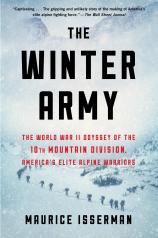The Winter Army: The World War II Odyssey of the 10th Mountain Division, America's Elite Alpine Warriors
Review
The Winter Army: The World War II Odyssey of the 10th Mountain Division, America's Elite Alpine Warriors
The best parts of THE WINTER ARMY are the chapters about the preparation for war, which sounds odd but isn’t in this context. The 10th Mountain Division came late to the Second World War, being the next-to-last division shipped to the European theater. But its genesis came long before, in 1929, with the publication of A FAREWELL TO ARMS. Hemingway’s classic novel about Alpine soldiers on the Italian front struck a chord with a New England insurance executive named Charles “Minnie” Dole, who in turn proposed to Franklin Roosevelt that the United States ought to have its own alpini --- soldiers who could fight and win in the difficult conditions of mountain warfare.
Roosevelt, although no kind of mountaineer, was nobody’s fool. He bucked the idea over to George Marshall, who okayed it. Before too much longer, a cadre of skiers and mountain climbers was eventually formed and sent to the high peaks of Colorado to train. And because, at that point in American history, climbing and skiing were primarily sports of the elite, the first troops in what would become the 10th Mountain Division tended to be wealthier and better educated than the common run of soldiers. And --- luckily for author Maurice Isserman --- at least some of them turned out to be good writers as well.
"...a sober, clear-eyed view of what it takes to train, equip and mount a fighting force, and the human cost borne by those brave men in the remote mountains of Italy who always pushed forward."
As was not too unusual for the Army of that era, the nascent 10th saw more than its share of mistakes. Its initial commander was a skeptic about the whole idea of mountain troops --- hardly ideal for what was a brand-new unit with an as-yet-uncertain mission. As the Army’s principal training sites were in lowland Southern locations like Fort Benning, a completely new camp had to be set up high in the Colorado Rockies to train the skiers to fight like soldiers. (The current 10th Mountain Division, Light Infantry, is housed at Fort Drum, in the mountains of upstate New York.) The division’s first mission was to a remote Alaskan island that --- unbeknownst to the Army --- had been evacuated by the Japanese prior to their arrival, leading to an embarrassing and deadly foul-up. And when the division was finally sent to the Italian front, it had to do so minus a good part of its supplies --- not least of which was the coveted “MOUNTAIN” patch for the division.
Although the 10th Mountain did not spend as much time in combat as other divisions, it more than exemplified the need for the Army to have an elite corps of soldiers ready to fight in mountain conditions. The German forces that inhabited the mountains of northern Italy were not crack troops --- one of their regiments was manned by old men and boys --- but they were in an enviable defensive position. Isserman details the slow, painful and deadly work needed to get men and material in place to fight the enemy. At times, the 10th Mountain built actual ski lifts to put Americans up on inaccessible heights like Riva Ridge.
Isserman’s history of the division balances nicely between the administrative details of fielding the division, and the hardships and losses that the division faced in battle --- some of them, in his opinion, unnecessary. THE WINTER ARMY is a sober, clear-eyed view of what it takes to train, equip and mount a fighting force, and the human cost borne by those brave men in the remote mountains of Italy who always pushed forward.
The insight of Charles Dole was that it would be easier to turn skiers into soldiers than the other way around. Ironically, there was very little skiing done by the men of the 10th Mountain --- and many of the replacement soldiers who came into the division later in the war had little to no mountain training at all. But he was right about the big idea, that America would need to fight in the mountains --- and the unit’s successor, the 10th Mountain Division, Light Infantry, has been fighting in the mountains of Afghanistan for much of that war. Isserman’s book is an illustration of that insight and how it was validated, and as such is valuable and telling.
Reviewed by Curtis Edmonds on November 22, 2019
The Winter Army: The World War II Odyssey of the 10th Mountain Division, America's Elite Alpine Warriors
- Publication Date: November 3, 2020
- Genres: History, Nonfiction
- Paperback: 352 pages
- Publisher: Mariner Books
- ISBN-10: 0358414245
- ISBN-13: 9780358414247




